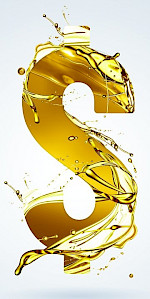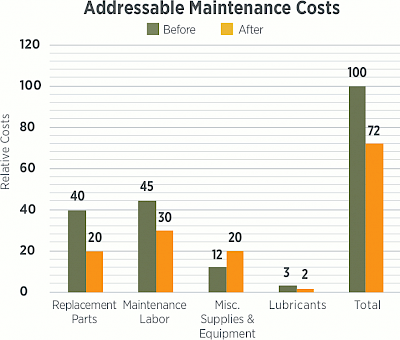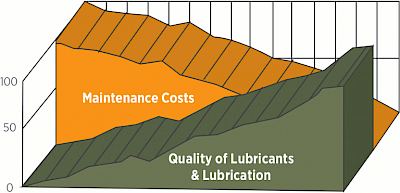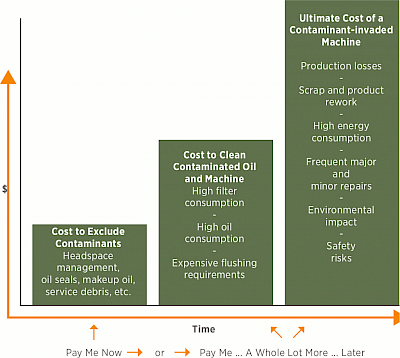5 Ways to Monetize Lubrication Excellence Now
 For most organizations, the opportunities for a substantial financial win from lubrication excellence are enormous with lots of low-hanging fruit. The most common financial benefit is reduced downtime by averting high-downtime machine failures. This strategy reveals the “hidden plant” and deploys proactive maintenance (root cause elimination) and predictive maintenance (early fault detection). And, sometimes you need a crisis to focus on reliability.
For most organizations, the opportunities for a substantial financial win from lubrication excellence are enormous with lots of low-hanging fruit. The most common financial benefit is reduced downtime by averting high-downtime machine failures. This strategy reveals the “hidden plant” and deploys proactive maintenance (root cause elimination) and predictive maintenance (early fault detection). And, sometimes you need a crisis to focus on reliability.
The problem with the hidden plant is that it requires spending dollars today to mitigate or prevent a future failure event. Yes, a dollar invested today may return $100 dollars or more in the future, but how long must one wait for the return? How certain are you that such an averted failure would have occurred?
For example, if you apply enhanced contamination control to just one machine, say a diesel engine, you might not see a benefit of an extended overhaul interval for more than a couple years. Conversely, if you have a fleet of diesel engines, the total number of overhauls (and lost production) might be reduced by 50 percent in any given time period including the current year.
Still, there are other tangible financial benefits that don’t relate to averted future failures. How can the cost of implementing a world-class lubrication program be paid for in today’s budgetary cycle? This is the theme of this article. Also, see Joe Anderson’s “How to Show the Value of a Lubrication Program” article.
Reducing Current Maintenance Costs
 See the chart in Figure 1. The green bars represent a typical maintenance budget. Note only 3 percent of the budget is the cost of lubricants. If today’s maintenance budget is to be reduced (to save money), the corresponding need for maintenance expenditures must be eliminated.
See the chart in Figure 1. The green bars represent a typical maintenance budget. Note only 3 percent of the budget is the cost of lubricants. If today’s maintenance budget is to be reduced (to save money), the corresponding need for maintenance expenditures must be eliminated.
The challenge is knowing what must be done to reduce the need for replacement parts (new and rebuilt), maintenance labor, supplies and lubricants. What wise and proven maintenance strategy achieves this objective? How much must be invested?
When it comes to precision or optimized lubrication, there is a need for change and often a modest investment. Done right, the results will not disappoint, a fact proven by many documented case studies. These cost reductions are represented by the orange bars in the chart. The magnitude of the benefit is proportional to how dire the current state of lubrication happens to be. The worse things are, the greater the opportunity. It also relates to how well-chosen and executed the optimized solution.
 Figure 2 shows this cause-and-effect in a more visual graphic. Failure to invest in change and enhanced lubrication puts the maintenance organization in a cycle of despair (left on the graphic). As the quality of lubrication sharply improves, so do the economic benefits. Everything hinges on action and change.
Figure 2 shows this cause-and-effect in a more visual graphic. Failure to invest in change and enhanced lubrication puts the maintenance organization in a cycle of despair (left on the graphic). As the quality of lubrication sharply improves, so do the economic benefits. Everything hinges on action and change.
Cost-avoidance Outside the Maintenance Budget
Some organizations become so accustomed to routine operational costs that they don’t recognize the low-hanging fruit in front of their eyes. A good example is poor energy management practices like what occurs in many aging homes today. Poor insulation, air drafts around doors and windows, out-of-date heating and air-conditioning units, etc., all add up to huge financial losses over time.
In the typical plant, there are many similar examples. Most are tangible (affecting today’s bottom line), and a few less so (more difficult to quantify). By focusing on what’s tangible, the cost of lubrication-enabled reliability effectively becomes self-funded and easier to approve by company decision-makers. Following is a list of potential savings outside the maintenance budget:
Lubrication's ROI
The Institute of Mechanical Engineers reports that lubrication represents a 1-to-40 return on investment (ROI). In other words, each $1,000 spent on improving lubricants and lubrication yields savings of $40,000.
Source: The Institute of Mechanical Engineers (IMECHE). “Wage War on Wear,” Tribology Action Handbook. From Shell LubePlanner.
- Operator idleness due to avoidable scheduled or unscheduled downtime (intangible)
- Lost or slowed production (tangible)
- Energy/fuel consumption costs (tangible)
- Product defects/spoilage (tangible)
- Leakage, waste and disposal costs (tangible)
- Over-budget overtime and other unplanned labor/contractor costs (tangible)
- Over-budget parts costs (tangible)
- Over-budget “rush” part shipping costs (tangible)
- Disruption of purchasing (intangible)
- Disruption of storeroom (intangible)
- Damage to staff morale (intangible)
- Loss of customer goodwill (intangible)
- Safety consequences (tangible and intangible)
- Environmental consequences (tangible and intangible)
The following itemizes ways to monetize a lubrication transformation without the need to avert a future failure event. In other words, it becomes a break-even business proposition within today’s budget cycle. Afterward, it’s all gravy.
1. Reducing Your Fuel and Energy Bill
One of a lubricant’s main functions is to reduce friction. This is achieved through lubricant selection and the method of lubrication. Even small differences in the choice and use of lubricants can have a huge impact on energy consumption. Based on what we’ve observed, this fact is not intuitive to most users and hence often missed.
Precision Viscosity
When it comes to energy economy, viscosity can be both an inhibitor and an enabler. The oil film produced by a lubricant is directly influenced by viscosity. However, too much viscosity causes churning losses (internal oil friction) and heat production, especially in engines, gears, bearings and hydraulics. It can also result in starvation.
Energy consumption is mostly influenced by the time-weighted average viscosity of the lubricant during the machine’s service life. Keep in mind the ISO viscosity grade system is based on 50-percent increments from one grade to the next. From the standpoint of energy consumption, the best choice often lies somewhere in between. Even then, precision viscosity selection can be achieved.
Precision Boundary Film-Strength Properties
Some lubricants gain film strength (reduction of contact friction and wear) from intrinsic properties of the base oil, especially certain synthetics. Other lubricants rely on additives such as friction modifiers, anti-wear and extreme-pressure agents, solid lubricants and fatty acids. The effectiveness of these additives in reducing wear, friction and energy consumption can fluctuate considerably between the different additive types employed. The performance of these additives also varies by machine and application. Good lubrication engineering is needed to find the optimum solution.
Grease Consistency
The consistency of grease can have an impact on energy consumption in ways similar to viscosity. The energy needed to move grease in frictional zones and in adjacent cavities by moving machine elements is affected by the lubricant’s consistency and chemistry.
Grease-Channeling Properties
A grease with good channeling characteristics helps keep the bulk lubricant away from moving elements, avoiding excessive churning and drag losses.
Effect of Contamination
One study discovered that particle contamination can increase fluid temperature by as much as 8 degrees C (due to increased friction). Increased cleanliness of crankcase oils has been found to reduce fuel consumption in diesel engines by 1 to 4 percent or more.
Too Much Lubricant
Overgreasing bearings is known to increase frictional losses and raise bearing temperature. The same is true for bearings that are underlubricated. For bath-lubricated bearings and splash-lubricated gears, a change in oil level by as little as one-half inch (1.3 centimeters) can increase temperature by more than 10 degrees C. This, of course, translates to greater energy consumption, shorter oil life and increased wear.
Air Robs Energy
Excessively aerated oils due to worn seals and wrong oil levels can have similar effects. Studies have also shown the negative effects of overextended oil change intervals on fuel economy in diesel engines. Deferred filter changes cause excessive flow resistance and fluid bypass.
Oil Mist
In the right application, there can be significant energy savings from total-loss lubricant delivery technologies such as oil mist and centralized lubrication systems. The amount of fluid that a machine uses to lubricate frictional surfaces at any moment is extremely small compared to the amount of fluid some machines must keep in continuous motion.
Wear Causes Energy Losses
Wear not only leads to machine operational failure but also impedes performance in the intervening period leading up to repair or overhaul. During this period, there usually is impaired productivity (efficiency) due to sluggish or erratic machine function, as well as increased energy consumption.
For instance, when hydraulic pumps and actuators wear, they lose volumetric efficiency. This slows work and increases the consumption of energy (and heat distress to the lubricant). Gears and bearings also consume more energy as a result of wear.
Even diesel engines suffer from decreasing combustion efficiency due to wear in the valve train, bottom-end bearings and combustion chambers (rings, pistons, cylinder walls, etc.). A corresponding increase in fuel consumption results.
2. Reducing Your Annual Lubricant Spend
As previously mentioned, lubricant procurement is not the largest expenditure in a typical maintenance budget. However, it is viewed as a real, tangible expense that is frequently targeted for cost reduction. Of course, it is unwise to pretend to save money by “buying cheap.” Because lubricants are the lifeblood of your machines, optimum reliability and lubrication must go hand in hand.
Following are six effective strategies for reducing your annual lubricant spend.
Precision Optimum-life Lubricant Selection
Optimum means optimum. Don’t overspend and most definitely don’t underspend. Resist the lure of cheap oil. Attempting to save money by buying economy-formulated lubricants for the wrong application is hazardous. Likewise, don’t be trapped by the false promise of forgiveness. It is equally hazardous to attempt to remedy bad lubrication practices by buying expensive premium lubricants.
Beware of small differences. Selecting the optimum lubricant for a machine application is an engineering process. Small differences in lubricant performance can translate into huge differences in machine reliability and lubricant cost. The critical role lubricant selection has on energy economy has already been discussed.
Being conservative with the number of lubricants in your plant is wise. Reduce the number of lubricants in your storeroom to a comfortable and efficient few. The number and range of lubricants you need will depend heavily on the types of machines and their operating environment.
Long-life lubricants in the right application make good sense. They extend drain intervals and lower the cost and risk of premature lubricant failure. Of course, when the lubricant fails, the machine is next. In many cases, selecting a long-life lubricant can reduce oil consumption by more than 50 percent.
| Gear Oil | Hydraulic Fluid | Turbine Oil | Motor Oil | Total | |
|---|---|---|---|---|---|
| Current Annual Spending | $70,000 | $120,000 | $180,000 | $40,000 | $410,000 |
| 1. Precision Optimum-life Lubricant Selection | -$15,000 | -$5,000 | -$21,000 | -$4,000 | -$45,000 |
| 2. Proactive Lubricant Life Extension | -$13,000 | -$3,000 | -$12,000 | -$3,000 | -$31,000 |
| 3. Optimizing the Relube Interval | -$6,000 | -$15,000 | 0 | -$5,000 | -$26,000 |
| 4. Reducing Package Waste | -$1,200 | -$2,200 | 0 | 0 | -$3,400 |
| 5. Reducing Leakage | -$500 | -$22,000 | 0 | 0 | -$22,500 |
| Optimized Annual Spending | $34,300 | $75,800 | $147,000 | $28,000 | $285,100 |
| Percent Cost Reduction 51% | 37% | 18% | 30% | 30% | |
| Annual Savings | $35,700 | $44,200 | $33,000 | $12,000 | $124,900 |
Extend the Lubricant’s Life
In normal service, lubricants age over time in a linear fashion. Eventually, they die due to additive depletion or other causes. However, life expectancy is not only related to the quality of the lubricant but also to the type and extent of stressful exposures.
The most destructive exposures come from contaminants such as heat, air and moisture. This has been discussed extensively in the pages of Machinery Lubrication. Most users greatly underestimate this opportunity.
Reconstruct Aged Lubricants
In many cases, additives in an aged lubricant should be reconstructed. Rather than disposing of all the oil and then replacing it, a far more economical approach would be to only replace the offending degraded additive. Although this practice may bring criticism from lubricant marketers, there are reputable service providers who can help make good decisions.
Optimizing the Relube Interval
Don’t change a lubricant too soon or too late. Many lubricants are changed using regimented practices or simple guesswork. Where possible, use oil analysis as your metric to optimize the interval and avoid premature disposal of an expensive commodity. For instance, if the oil is analyzed at the end of a typical service interval and the remaining useful life (RUL) is found to be 75 percent, extend the interval for the next drain and charge. Keep fine-tuning the interval until an optimum interval is found.
Many machines should not be subjected to interval-based oil changes at all. Instead, their lubes should be changed “on condition” and only when there is a true need. Let the oil tell you when it needs to be changed, not the calendar.
In certain applications, grease lubrication can also be optimized from the standpoint of the relube frequency and amount. This can be achieved through grease analysis (with proper sampling) and by inspecting used grease in bearing and motor rebuilds.
Reduce Package Waste
Many lubricants sold in drums and packages fail to get fully consumed. Frequently, unused lubricant is left behind in the package. Various strategies can help to minimize waste oil, including using smaller packages or bulk oil. These tactics should be optimized for the machine or group of machines in which the lubricant is used.
Another culprit of waste is the top-up container. These small containers that are carried to the point of lubricant application are often partially full when they are set aside. The oil left in the container is later questioned regarding its type and condition.
 Reduce Leakage
Reduce Leakage
Leakage control makes good sense for a number of reasons. Not only are there lubricant consumption savings but also reliability and safety benefits. Don’t turn a blind eye to leakage; address it early. Avoid Band-Aid fixes, and instead seek permanent and complete solutions. Two things greatly influence this: the quality and cleanliness of the lubricant and inspection.
Figure 3 offers a hypothetical example of the potential for reducing lubricant consumption and overall annual lubricant spending. The opportunities vary considerably depending on the current amount of waste and inefficiency in your plant.
3. Reducing Annual Spend on Contamination Control
There is a price tag for removing dirt from oil. For large plants and fleets operating in dusty environments, the cost can be substantial. Where rigorous contamination control is needed (most cases), you still have a few options to get the most cleanliness for the fewest dollars.
Stop the Ingress
It goes without saying that filters last longer when they don’t get plugged with particles. Therefore, the best strategy comes from working backward by tracing the contaminant ingression pathway. Then, start the process of exclusion by systematically blocking these free-pass entry points. It often is said that the cost of excluding a gram of dirt is only about 10 percent of what it will cost you once the dirt is allowed to get into the oil (Figure 4).
Select Economy Filtration
This can be broken down into two categories: economic filters and economic filtration. Economic filters relate to such considerations as filter size, media type, dirt-holding capacity, etc. Economic filtration involves the system and operating conditions, such as flow density, pressure and filter location, as well as the use of multiple filters, filter carts, centrifuges, etc. It also is associated with the optimum filter change interval.
Controlling contaminant ingression and optimizing the selection and use of filtration can produce considerable economic rewards. The impact on your energy bill and annual lubricant spend has already been discussed, but there are many other directly related economic factors, including replacement parts, labor, productivity, etc. Getting wise and balanced advice on this can be an economic windfall.
| Operating & Maintenance Savings | Initial Investment (Non-recurring) | Annual Savings | 1st Year Return on Investment | 2nd Year & Beyond |
|---|---|---|---|---|
| Reducing Your Fuel and Energy Bill | $30 | $30 | 0 | $30 |
| Reducing Your Lubricant Spend | $20 | $10 | $10 | $10 |
| Reducing Spend on Contamination Control | $20 | $10 | $10 | $10 |
| Precision PMs, Fewer Work Orders | $10 | $30 | ($20) | $30 |
| Unifying Condition Monitoring with Inspection | $20 | $20 | 0 | $20 |
| Total | $100 | $100 | 0 | $100 |
| Annual Savings from Downtime Reduction | $50 | $50 | $400+ | |
| Total Return | $150 | $50 | $450+ |
4. Precision PMs, Fewer Work Orders
Preventive maintenance (PM) tasks are resource-intensive and expensive. Optimize your program by recalibrating PMs. Optimization means doing some pruning of wasteful tasks and adding others to fill holes in your PM scheme. Most importantly, bulletproof your strategy to ensure there are no high-risk failure modes that don’t have a PM countermeasure (such as inspection).
Assess What Is Being Done
Many PMs are unnecessary or redundant, while others like key inspections are casually ignored. In some cases, condition-based maintenance was added with the intention of replacing scheduled component changeouts. However, these changeouts often continue despite the added condition monitoring. Basic-care PMs are essential to the health of machines and include lubrication, proper fastener management, balance, alignment and other proactive measures to extend the life of the equipment.
Examine How PMs Are Performed
Some PMs do more harm than good. Others perpetuate antiquated methods that should have been replaced with modern tools and methods. Re-examine essential lubrication care related to the well-known “rights of lubrication.”
De-risk failure-inducing tasks by upskilling technicians, adding better tools, and re-examining procedures and workplans. Simple tasks like greasing a motor bearing can cause sudden-death failures when performed improperly. Remove task ambiguity such as “check pressure,” “check temperature,” “inspect electrical system,” etc. What do these tasks really mean? Without a clear definition of what OK looks like, inspections can be empty and valueless.
Revisit Task Frequency
Poorly timed PMs waste valuable resources or neglect opportunities. Optimize frequency based on criticality, failure modes and need. The importance of condition-based oil and filter changes (as opposed to schedule-based) has already been discussed.
Grease lubrication is another PM task that is frequently performed at the wrong interval. Sadly, when a machine fails for causes unknown, we often react in a knee-jerk fashion. For instance, we may attempt to remedy things by increasing the regreasing frequency and volume. While the intention is good, this just makes matters worse. Then, the new PM interval becomes the de facto standard, and nobody recalls the reason why.
Design Smart PM Route Sequences
PM routes should be sequenced according to the frequency, required tools, lube type, location (proximity) and urgency. Optimize the routes to reduce wasted time and resources.
Manage Compliance and Backlog
Keep route compliance on a very short leash. Watch work-order backlog and overall maintenance debt very carefully. The worse things get, the faster they get worse. Unfortunately, many organizations get behind on proactive maintenance PMs because they are too busy working on the backlog of urgent repairs. Breakdown maintenance doesn’t “prevent” anything. Stop the insanity!
5. Unifying Condition Monitoring with Inspection
For most plants, condition monitoring consists of multiple technologies that are cobbled together in an attempt to enhance machine reliability. Clearly, these efforts are founded on good intentions, and many such programs enjoy considerable success. Still others languish due to a lack of symmetry and central focus. Money is spent and effort expended, but the results are often disappointing.
Condition monitoring requires a strategic and efficient foundation for alignment. This begins with understanding machine criticality and failure modes. Alignment greatly helps to optimize deployment of activities and spending to minimize waste and redundancy. Alignment also keeps maintenance and reliability professionals on the same page by providing a clear understanding of what’s being done and why.
Unification refers to bringing all condition monitoring efforts into a purposeful, cohesive focus. This includes vibration, ultrasound, oil analysis, thermography, etc., but it must also incorporate the human data collector who has sensors far exceeding anything technology can offer to look, listen, feel and smell. These super-sensors are wired to a super-computer in the inspector’s brain. Ever wonder why airport screening of carry-on bags still depends on humans to analyze and inspect 2D images?
Optimize oil analysis and in certain cases substitute onsite oil analysis. Many non-critical machines can get by with simple onsite oil analysis inspections instead of expensive, full-on lab work (at least for screening purposes). Basic onsite examinations that are extremely effective include patch testing, viscosity comparator, crackle test, clear and bright, and manual ferrous density. Frequently performed inspections at the machine are often far more effective than less frequent lab analysis of oil in sample bottles.
Unification and alignment are an engineering process that has the potential to yield huge benefits in reducing current condition monitoring costs as well as optimizing the state of machine reliability.
What Does It All Mean?
It’s very simple: why wait? Warren Buffett once said, “I’d rather be approximately right than precisely wrong.” Don’t overplan, overprepare or wait for the perfect time. Instead, spring into action now.
Figure 5 is a simplistic tally of how investing in lubrication excellence now can be self-funded painlessly through the current operating and maintenance budget. Yes, some faith or trust is involved, but remember that many others have been down this road. Their amazing results are known and documented for public view. Refer to the countless case studies found at MachineryLubrication.com and make your plant the next documented success story.
